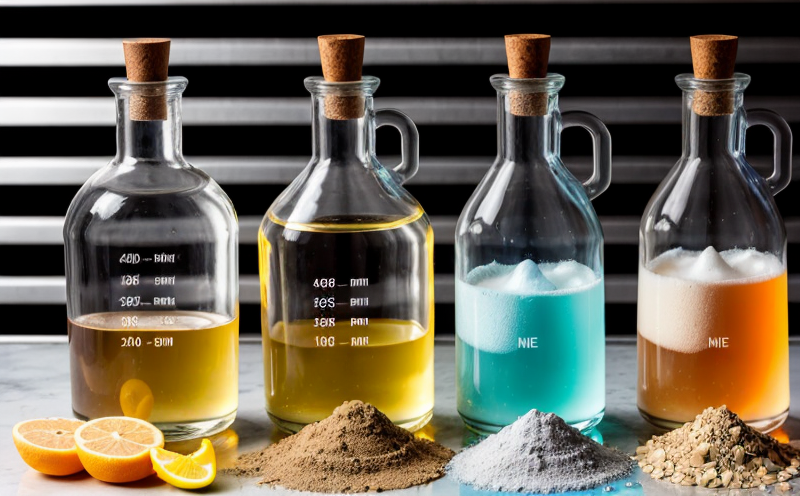GB/T 31484 Electrolyte Composition Analysis of Lithium-Ion Cells
The analysis of electrolyte composition in lithium-ion cells is a critical aspect of ensuring the safety, performance, and longevity of these batteries. GB/T 31484 provides standardized procedures for determining the chemical composition of the electrolyte used in lithium-ion cells. This service ensures that manufacturers and researchers can meet stringent regulatory requirements while also optimizing product quality.
The electrolyte is a key component responsible for facilitating ion transport between the cathode and anode, which enables charge and discharge processes. The correct balance of chemical constituents within this liquid or solid-electrolyte interface is essential to prevent overcharging, overheating, and other potential hazards. By conducting accurate GB/T 31484 tests, laboratories can guarantee that the electrolyte meets the specified standards set forth by international bodies like the International Organization for Standardization (ISO).
The GB/T 31484 method focuses on quantifying specific chemical components such as lithium salts, solvents, and additives. Lithium hexafluorophosphate (LiPF6) is often a primary component due to its high solvating power and stability. Other key elements include ethylene carbonate (EC), diethyl ether (DEO), and propylene carbonate (PC). The presence of these substances directly influences the battery's capacity, cycle life, and overall safety.
Preparation for GB/T 31484 testing involves several steps. Initially, a representative sample must be taken from the lithium-ion cell. This typically means collecting a small amount of electrolyte solution using sterile techniques to avoid contamination. Once collected, this material undergoes dilution according to specified ratios outlined in the standard. Properly preparing the sample ensures accurate results during subsequent analysis.
Analysis itself relies on sophisticated analytical instruments capable of detecting minute quantities of various compounds at different concentrations levels. Common methods include high-performance liquid chromatography (HPLC), gas chromatography-mass spectrometry (GC-MS), and Fourier transform infrared spectroscopy (FTIR). These techniques allow for precise measurement of key electrolyte components, providing detailed information about their relative amounts.
After completing the analysis, laboratories generate comprehensive reports detailing findings. These documents include quantitative data on all measured parameters along with any relevant qualitative observations. Compliance with GB/T 31484 requirements is essential not only for meeting industry standards but also ensuring safe and reliable performance in real-world applications.
Regular monitoring of electrolyte composition helps identify potential issues early, allowing for timely adjustments to manufacturing processes if necessary. This proactive approach enhances product reliability and extends service life significantly. Additionally, adherence to these tests demonstrates commitment to quality control practices valued by customers worldwide.
Why It Matters
Accurate electrolyte composition analysis plays a pivotal role in maintaining the safety and efficiency of lithium-ion cells used across various sectors. From electric vehicles (EVs) to portable electronics, these batteries power modern technologies that demand reliability and durability.
In EVs specifically, proper electrolyte formulation impacts driving range, charging speeds, and battery lifespan. An optimal balance between lithium salts and solvents ensures efficient energy transfer without causing thermal runaway—a dangerous condition where excessive heat could lead to catastrophic failures.
For consumer electronics like smartphones and laptops, consistent quality control through GB/T 31484 testing helps manufacturers deliver products free from defects or performance shortfalls. Moreover, compliance with international standards builds trust among end-users regarding product safety and environmental impact.
Beyond mere technical specifications, ensuring accurate electrolyte composition also contributes to sustainability efforts by minimizing resource waste during production cycles. By optimizing the use of raw materials, manufacturers can reduce costs while contributing positively towards global environmental goals.
Industry Applications
The application of GB/T 31484 electrolyte composition analysis spans multiple industries where lithium-ion cells are integral components. Notably, the automotive sector heavily relies on this service for electric vehicle development and manufacturing.
Automakers like Tesla and BYD employ rigorous testing protocols to ensure their batteries meet strict safety and performance benchmarks. Similarly, within consumer electronics firms such as Apple and Samsung, quality assurance departments leverage these tests to maintain high standards of product integrity.
Battery manufacturers also benefit greatly from this service by validating the consistency of their electrolyte batches throughout production lines. Research institutions involved in energy storage technology research further utilize GB/T 31484 methods to explore new materials and formulations aimed at improving battery characteristics.
Use Cases and Application Examples
In the context of electric vehicles, GB/T 31484 electrolyte composition analysis supports several critical use cases:
Optimizing Charging Efficiency: Ensuring that the correct ratio of lithium salts to solvents exists within each cell enhances charging efficiency. This improves both range and speed without compromising safety.
Preventing Thermal Runaway: By accurately measuring electrolyte components, potential hazards such as overheating can be mitigated effectively. This contributes significantly towards enhancing overall vehicle reliability and passenger comfort.
Evaluating Material Stability: Over time, some materials may degrade or lose efficacy. Continuous monitoring via GB/T 31484 ensures that any changes are promptly addressed, preserving optimal performance over extended periods.
In consumer electronics, this service supports various applications:
Enhancing Battery Lifespan: Accurate electrolyte composition ensures longer-lasting batteries for devices like smartphones and tablets. This translates into reduced replacement needs and lower lifecycle costs for users.
Safeguarding Consumer Safety: By adhering to strict standards, manufacturers can reassure consumers that their products meet the highest safety criteria. This builds brand loyalty and customer trust.





